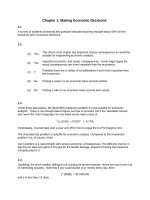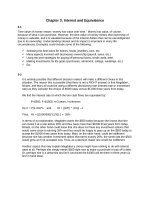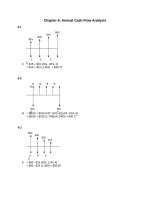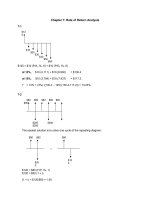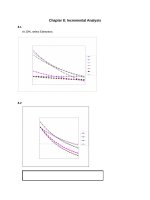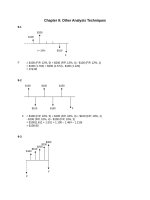Solution manual engineering economic analysis 9th edition ch16
Bạn đang xem bản rút gọn của tài liệu. Xem và tải ngay bản đầy đủ của tài liệu tại đây (83.14 KB, 16 trang )
Chapter 16: Economic Analysis in the Public Sector
16-1
Public decision-making involves the use of public money and resources to fund public
projects. Often there are those who are advocating for particular projects, those who oppose
projects, those who will be immediately affected by such project, and those who may be
affected in the future. There are those who represent their own stated interests, and those
who are representing others’ interests. Thus the “multi-actor” aspect of the phrase refers to
the varied and wide group of “stakeholders” who are involved with, affected by, or place
some concern on the decision process.
16-2
Public decision-making is focused on promoting the general welfare of the aggregate public.
There is an explicit recognition in promoting the good of the whole, in some cases, that
individual’s goals must be subordinate (e.g. eminent domain). Private decision making, on
the other hand, is generally focused on increasing stakeholder wealth or investment. This is
not to say that private decision-making is entirely focuses on financials, clearly private
decision-making focuses on non-monetary issues. However, the goal and objective of the
enterprise is economic survival and growth and thus the primary objective is financial in
nature (for without success financially all other objectives are moot is the firm dissolves).
16-3
The general suggestion is that the viewpoint should be at least as broad as those who pay
the costs and/or receive the benefits. This approach balances local decisions, which may
sub-optimize decision making if not taken. Example 16-1 describes this dilemma for a
municipal project funded partly by federal money (50%). In this example, it still made sense
to approve the project from the municipality’s viewpoint but not the federal government, after
the benefit estimate was revised.
16-4
This phrase refers to the fact that most benefits are confined locally for government
investments. As the authors state, “Other than investments in defense and social programs,
most benefits provided by government are realized at the local or regional levels.” This is
true for projects funded with full or partial government money. The conflict arises when
some regions, states, municipalities perceive that they are consistently passed over for
projects that would benefit their region, state, municipality. Powerful members in congress,
and state legislatures, with key committee/subcommittee appointments can influence
government spending in their districts. Politics have an effect in this regard. However, many
projects, including the US parks system, the interstate highway, and others reach many
beyond even regional levels.
16-5
Students will pull elements from the discussion of this topic in the textbook. In the text the
concepts discussed include (1) No Time Value of Money, (2) Cost of Capital, and (3)
Opportunity Cost. The Recommended Concept is to select the largest of the cost of capital,
the government opportunity cost, or the taxpayer opportunity cost.
16-6
The conventional benefit-cost ratio has net benefits to the users in the numerator and cost to
the sponsor in the denominator. The modified B-C ratio takes the project operating and
maintenance costs paid by the sponsor, and subtracts these from the net benefits to the
users. This quantity is all in the numerator. These leaves only the projects initial costs in the
denominator.
The conventional and modified versions of the B-C ratio use different algebra/math to
calculate the ration, but the resulting recommendation will always be the same. That is, for
any problem, both ratios will either be greater than or less than 1.0 at the same time.
16-7
This is a list of potential costs, benefits, and disbenefits for a nuclear power plant.
Costs
Land Acquisition
Site Preparation
Cooling System
- Reservoir dams
- Reservoir cooling
Construction
- Reactor vessel/core
- Balance of plant
- Spent fuel storage
- Water cleaning
Benefits
Environment
- No greenhouse gas
- No leakage
- No combustion
Jobs & Economy
- At enrichment plants
- At power plant
- Increase tax base
Increase Demand
- Uranium plants
Disbenefits
Fission product material to
contend with forever
Not in my backyard
Risk of Reactor
- Real
- Psychological
Loss to Economy
- Coal
- Electric
16-8
(a)
The conventional and modified versions of the B/C Ratio will always give consistent
recommendations in terms of “invest” or “do not invest”. However, the magnitude of
the B/C Ratio will be different for the two methods. Advocates of a project may use
the method with the larger ratio to bolster their advocacy.
(b)
Larger interest rates raise the “cost of capital” or “lost interest” for public projects
because of the sometimes quite expensive construction costs. A person favoring a
$200 M turnpike project would want to use lower i% values in the B/C Ratio
calculations to offset the large capital costs.
(c)
A decision-maker in favor of a particular public project would advocate the use of a
longer project in the calculation of the B/C ratio. Longer durations spread the large
initial costs over a greater number of years.
(d)
Benefits, costs and disbenefits are quantities that have various amounts of
“certainty” associated with them. Although this is true for all engineering economy
estimates it is particularly true for public projects. It is much easier to estimate labor
savings in a production environment than it is to estimate the impact on local hotels
of new signage along a major route through town. Because benefits, costs, and
disbenefits tend to have more uncertainty it is therefore easier to manipulate their
values to make a B/C Ratio indicate a decision with your position.
16-9
The time required to initiate, study, fund and construct public projects is generally several
years (or even decades). Because of this it is not uncommon for there to be turnover in
public policy makers. Politicians, who generally strive to maintain a positive public image,
have been known to “stand up and gain political capital” from projects that originally began
many years before they took office.
16-10
Benefit- Cost Ratio = PW of Benefits/PW of Cost
= [$20,000 (P/A, 7%, 9) (P/F, 7%, 1)]/[$100,000
+ $50,000 (P/F, 7%, 1)]
= [$20,000 (6.515) (0.9346)]/[$100,000
+ $50,000 (0.9346)]
= 0.83
16-11
The problem requires the student to use calculus. The text points out in Example 8-9 (of
Chapter 8) that one definition of the point where ∆B = ∆C is that of the slope of the benefits
curve equals the slope of the NPW = 0 line.
2
0
1
8
1
6
1
4
1
2
1
0
8
6
4
2
0
2 4 6 8 10 12 14
16 18 PW
20 of Cost
Values for the graph:
PW of Cost (x)
2
4
6
8
10
12
16
20
PW of Benefits (y)
0
6.6
9.4
11.5
13.3
14.8
17.6
19.9
Let x = PW of Cost and y = PW of Benefits
y2 – 22x + 44 = 0
or
y = (22x – 44)1/2
= ½ (22x – 44)(-1/2) (22)
=1
(Note that the slope of the NPW = 0 line is 1)
22x – 44 = [(1/2) (22)]2
x
= (112 + 44)/22= 7.5 = optimum PW of cost
dy/dx
16-12
Since we have a 40-year analysis period, the problem could be solved by any of the exact
analysis techniques. Here the problem specifies a present worth analysis. The annual cost
solution, with a 10% interest rate, is presented in problem 6-44.
Gravity Plan
PW of Cost
Pumping Plan
PW of Cost
= $2,800,000 + $10,000 (P/A, 8%, 40)
= $2,800,000 + $10,000 (11.925) = $2,919,250
= $1,400,000 + $200,000 (P/F, 8%, 10)
+ ($25,000 + $50,000) (P/A, 8%, 40)
+ $50,000 (P/A, 8%, 30) (P/F, 8%, 10)
= $1,400,000 + $200,000 (0.4632)
+ ($25,000 + $50,000) (11.925)
+ $50,000 (11.258) (0.4632)
= $2,647,700
To minimize PW of Cost, choose pumping plan.
16-13
(a) Conventional B/C Ratio
= [PW (Benefits – Disabilities)]/[PW (1st Cost + Annual Cost)]
= [($500,000-$25,000) (P/A, 10%, 35)]/[($1,200,000
+ $125,000) (P/A, 10%, 35)]
= 1.9
(b) Modified B/C Ratio
= [PW (Benefits – Disbenefits – Cost)]/[PW (1st Cost)]
= [($500,000 - $25,000 - $125,000) (P/A, 10%, 35)]/$1,200,000
= 2.8
16-14
Using the Conventional B/C Ratio
(i) Using PW
(ii) Using AW
B/C Ratio = 1.90 (as above)
B/C Ratio = ($500,000 - $25,000)/[$1,200,000 (A/P,10%,35)
+ $125,000]
= 1.90
(iii) Using FW
B/C Ratio = [($500,000 - $25,000) (F/A,10%,35)]
/[$1,200,000 (F/P, 10%, 35) + $125,000 (F/A, 10%,
35)]
= 1.90
16-15
(a) B/C Ratio
= [($550 - $35) (P/A, 8%, 20)]/[($750 + $2,750)
+ $185 (P/A, 8%, 20)]
= 0.95
(b) Let’s find the breakeven number of years at which B/C = 1.0
1.0= [($550 - $35) (P/A, 8%, x)]/[($750 + $2,750)
+ $185 (P/A, 8%, x)]
By trial and error:
x
B/C
ratio
24 years 0.995
25 years 1.004
26 years 1.031
One can see how Big City Carl arrived at his value of “at least” 25 years for the project
duration. This is the minimum number of years at which the B/C ratio is greater than 1.0
(nominally).
16-16
Annual Travel Volume
= (2,500) (365) = 912,500 cars/year
The High Road
1st Cost
Annual Benefits
Annual O & M Cost
= $200,000 (35)
= 0.015 ($912,500) 35)
= $2,000 (35)
The Low Road
= $7,000,000
= $479,063
= $70,000
1st Cost
Annual Benefits
Annual O & M Cost
= $450,000 (10)
= $4,500,000
= 0.045 ($912,500) (10)
= $410,625
= $10,000 (10)
= $100,000
These are two mutually exclusive alternatives; we use an incremental analysis process.
Rank Order based on denominator = Low Road, High Road
∆ 1st Cost
∆ Annual Benefits
∆ Annual O & M
Costs
∆B/∆C
Justified?
Do Nothing-vs.-Low
$4,500,000
$410,625
$100,000
Low-vs.-High
$2,500,000
$68,438
-$30,000
1.07a
Yes
0.61b
No
Recommend investing in the Low road, it is the last justified increment.
a
b
[($410,625 - $100,000) ($15,456)]/$4,500,000
= 1.07
[($68,438 + $30,000) ($15,456)]/$2,500,000 = 0.61
16-17
(a) PW of Benefits
= $60,000 (P/A, 5%, 10)
+ $64,000 (P/A, 5%, 10) (P/F, 5%, 10)
+ $66,000 (P/A, 5%, 20) (P/F, 5%, 20)
+ $70,000 (P/A, 5%, 10) (P/F, 5%, 40)
= $60,000 (7.722)
+ $64,000 (7.722) (0.6139)
+ $66,000 (12.462) (0.3769)
+ $70,000 (7.722) (0.1420)
= $1,153,468
For B/C ratio = 1,
PW of Cost = PW of Benefits
Justified capital expenditure
= $1,153,468 - $15,000 (P/A, 5%, 5)
= $1,153,468 - $15,000 (18.256)
= $879,628
(b) Same equation as on previous page except use 8% interest
PW of Benefits
= $60,000 (6.710) + $64,000 (6.710) (0.4632)
+ $66,000 (9.818) (0.2145)
+ $70,000 (6.710) (0.0460)
= $762,116
Justified Capital Expenditure
= $762,116 - $15,000 (12.233)
= $578,621
16-18
Plan A
n = 15
n = 15
$75,000
n = 10
$125,000
$250,000
$250,000
$300,000
$300,000
Plan B
$150,000
n = 15
$100,00
0
n = 25
$125,000
$50,000
$450,000
Differences between Alternatives A and B
$300,000
$200,000
$150,000
$125,000
n = 15
n = 15
$25,000
$150,000
n = 10
An examination of the differences between the alternatives will allow us to quickly determine
which plan is preferred.
Cash Flow
Year
A
0
-$300
1- 15
-$75
15
-$250
16- 30
-$125
30
-$300
31- 40
-$250
40
$0
Sum
B
-$450
-$100
-$50
-$125
$0
-$125
+$150
Present Worth
B- A
At 7%
-$150
-$150
-$25
-$228
+$200
+$72
$0
$0
+$300
+$39
+$125
+$115
+$150
+$10
+$1,375*
-$142
At 5%
-$150
-$259
+$96
$0
+$69
+$223
+$21
$0
* This is sum of -$150 – 15 ($25) + $200 ….
(a)
When the Present Worth of the B- A cash flow is computed at 7%, the NPW = -142.
The increment is not desirable at i = 7%.
Choose Plan A.
(b)
For Plan B to be chosen, the increment B- A must be desirable. The last column in
the table above shows that the B- A increment has a 5% rate of return. In other
words, at all interest rates at or below 5%, the increment is desirable and hence Plan
B is the preferred alternative. The value of MARR would have to be 5% or less.
16-19
Overpass Cost = $1,800,000
Salvage Value = $100,000
Benefits to Public
Time Saving
for 100 vehicles per day
400 trucks x (2/60) x ($10/hr) = $240 per day
600 others x (2/60) x ($5/hr) = $100 per day
Total = $340 per day
Benefits to the State
Saving in accident investigation costs= $2,000 per year
Combined Benefits
Benefits to the Public + Benefits to the State
= $340/day (365 days) + $6,000
= $130,100 per year
Benefits to the Railroad
Saving in crossing guard expense
= $48,000 per year
Saving in accident case expense = $60,000 per year
Total
= $108,000 per year
n = 30
i = 6%
Should the overpass be built?
Benefit- Cost Ratio Analysis
Annual Cost (EUAC)
= $1,700,000 (A/P, 6%, 30) + $100,000 (0.06)
= $1,700,000 (0.0726) + $6,000
= $129,420
Annual Benefit (EUAB)
= $130,100 + $108,000
= $238,100
B/C= EUAB/EUAC
= $238,100/$129,420 = 1.84
With a B/C ratio > 1, the project is economically justified.
Allocation of the $1,800,000 cost
The railroad should contribute to the project in proportion to the benefits received.
PW of Cost
= $1,800,000 - $100,000 (P/F, 6%, 30)
= $1,800,000 - $100,000 (0.1741)
= $1,782,590
The railroad portion would be
($108,000/$238,100) ($1,782,590) = $808,570
The State portion would be
($130,100/$238,100) ($1,782,590) + $100,000 (P/F, 6%, 30)
= ($130,100/$238,100) ($1,782,590) + $100,000 (0.1741)
= $991,430
Note that $808,570 + $991,430 = $1,800,000
While this problem is a simplified representation of the situation, it illustrates a realistic
statement of benefits and an economic analysis solution to the allocation of costs.
16-20
Length (miles)
Number of Lanes
Average ADT
Autos
Trucks
Time Savings (minutes)
Autos
Trucks
Existing
10
2
20,000
19,000
1,000
Plan A
10
4
20,000
19,000
1,000
Plan B
10
4
20,000
19,000
1,000
Plan C
10.3
4
20,000
19,000
1,000
2
3
5
Accident Rate/MVM
Initial Cost per mil (P)
Annual Maintenance per
lane per mile
Total Annual Maintenance
EUAC of Initial Cost = (P x
miles) (A/P, 5%, 20)
Total Annual Cost of EUAC
+ Maintenance
4.58
$1,500
1
2.50
$450,000
$1,250
3
2.40
$650,000
$1,000
4
2.30
$800,000
$1,000
$30,000
$0
$50,000
$360,900
$40,000
$521,300
$41,200
$660,850
$30,000
$410,900
$561,300
$702,050
Annual Incremental Operating Costs due to distance
None for Plans A and B, as they are the same length as existing road.
Plan C Autos 19,000 x 365 x 0.3 mi x $0.06
= $124,830
Trucks 1,000 x 365 x 0.3 mi x $0.18 = $19,710
Total = $144,540/yr
Annual Accident Savings compared to Existing Highway
Plan A:
(4.58 – 2.50) (10-6) ( 10 mi) (365 days) (20,000 ADT) ($1,200)
= $182,200
Plan B:
(4.58 – 2.40) (10-6) ( 10 mi) (365 days) (20,000 ADT) ($1,200)
= $190,790
Plan C:
(4.58 – 2.30) (10-6) ( 10.3 mi) (365 days) (20,000 ADT) ($1,200)
= $205,720
Time Savings Benefits to Road Users compared to Existing Highway
Plan A:
Autos
Trucks
Plan B:
Autos
Trucks
Plan C:
Autos
Trucks
19,000 x 365 days x 2 min x $0.03
1,000 x 365 days x 1 min x $0.15
Total
= $416,100
= $54,750
= $470,850
19,000 x 365 days x 3 min x $0.03
1,000 x 365 days x 3 min x $0.15
Total
= $624,150
= $164,250
= $788,400
19,000 x 365 days x 5 min x $0.03
1,000 x 365 days x 4 min x $0.15
Total
= $1,040,250
= $219,000
= $1,259,250
Summary of Annual Costs and Benefits
Annual Highway Costs
Annual Benefits
Existing
$30,000
Plan A
$410,900
Plan B
$561,300
Plan C
$702,050
Accident Savings
Time Savings
Additional Operating Cost*
Total Annual Benefits
$182,200
$470,850
$190,970
$788,400
$653,050
$979,370
$205,720
$1,259,250
-$144,540
$1,320,430
* User costs are considered as disbenefits.
Benefit-Cost Ratios
A rather than Existing:
B rather than A:
C rather than B:
B/C = $653,050/($410,900 - $30,000)
= 1.71
B/C = ($979,370 - $653,050)/($561,300 - $410,900)
= 2.17
B/C = ($1,320,430 - $979,370)/($702,050 - $561,300
= 2.42
Plan C is preferred.
16-21
G = $2,000
x
n = 15 yrs
i = 6%
$275,00
0
Compute X for NPW = 0
NPW
X
= PW of Benefits – PW of Costs
= X (P/A, 6%, 15) + $2,000 (P/G, 6%, 15) - $275,000
= X (9.712) + $2,000 (57.555) - $275,000
= $0
= [$275,000 - $2,000 (57.555)]/9.712
= $0
= $16,463
Therefore, NPW at yr 0 turns positive for the first time when X is greater than $16,463. This
indicates that construction should not be done prior to 19x5 as NPW is not positive. The
problem thus reduces to deciding whether to proceed in 2005 or 2006. The appropriate
criterion is to maximize NPW at some point. If we choose the beginning of 2005 for
convenience,
Construct in 2005
NPW2005
= $18,000 (P/A, 6%, 15) + $2,000 (P/G, 6%, 15) - $275,000
= $18,000 (9.712) +$2,000 (57.555) - $275,000
= +$14,926
Construct in 2006
NPW2006
= [$20,000 (P/A, 6%, 15) + $2,000 (P/G, 6%, 15)
- $265,000] (P/F, 6%, 1)
= [$20,000 (9.712) + $2,000 (57.555) - $275,000] (0.9434)
= +$32,406
Conclusion: Construct in 2006.
16-22
It is important to recognize that if Net Present Worth analysis is done, then the criterion is to
maximize NPW. But, of course, the NPWs must be computed at a common point in time,
like Year 0.
Repair Now
NPWYEAR 0 = $5,000 (P/F, 15%, 1) + $10,000 (P/G, 15%, 5)
+ $50,000 (P/A, 15%, 5) (P/F, 15%, 5) -$150,000
= $5,000 (0.8696) + $10,000 (5.775)
+ $50,000 (3.352) (0.4972) -$150,000
= -$4,571
Repair Two Years Hence
NPWYEAR 2 = $20,000 (P/A, 15%, 3) + $10,000 (P/G, 15%, 3)
+ $50,000 (P/A, 15%, 7) (P/F, 15%, 3) - $150,000
= $20,000 (2.283) + $10,000 (2.071)
+ $50,000 (4.160) (0.6575) - $150,000
= +$53,130
NPWYEAR 0 = $53,130 (P/F, 15%, 2)
= $53,130 (0.756)
= +$40,172
Repair Four Years Hence
NPWYEAR 4 = $50,000 (P/A, 15%, 10) - $10,000 (P/F, 15%, 1) - $150,000
= $50,000 (5.019) - $10,000 (0.8696) - $150,000
= +$92,254
NPWYEAR 0 = $92,254 (P/F, 15%, 4)
= $92,254 (0.5718) = +$52,751
Repair Five Years Hence
NPWYEAR 5 = $50,000 (P/A, 15%, 10) - $150,000
= $50,000 (5.019) - $150,000
= +$100,950
NPWYEAR 0 = $100,950 (P/F, 15%, 5)
= $100,950 (0.4972) = +$50,192
To maximize NPW at year 0, repair the road four years hence.
It might be worth noting in this situation that since the benefits in the early years (Years 1, 2,
and 3) are less than the cost times the interest rate ($150,000 x 0.15 = $22,500), delaying
the project will increase the NPW at Year 0. In other words, we would not expected the
project to be selected (if it ever would be) until the annual benefits are greater than $22,500.
If a “repair three years hence” alternative were considered, we would find that it has an
NPW at year 0 of +$49,945. So the decision to repair the road four years hence is correct.
16-23
This problem will require some student though on how to structure the analysis. This is a
situation of providing the necessary capacity when it is needed- in other words Fixed Output.
Computing the cost is easy, but what is the benefit?
One cannot compute the B/C ratio for either alternative, but the incremental B/C ratio may
be computed on the difference between alternatives.
Year
A
Half capacity tunnel now plus half
capacity tunnel in 20 years
B
Full Capacity
Tunnel
0
10
20
-$300,000
-$16,000
-$16,000
-$400,000
-$32,000
-$32,000
$0
-$500,000
-$20,000
-$20,000
B- A
Difference
Between the
alternatives
-$200,000
-$4,000
+$396,000
-$20,000
-$20,000
$0
+$12,000
+$12,000
$0
30
40
50
∆B/∆C = [$396,000 (P/F, 5%, 20) + $12,000 (P/F, 5%, 30)
+ $12,000 (P/F, 5%, 40)]/[$200,000 + $4,000 (P/F, 5%, 10)]
= $153,733/$202,456
= 0.76
This is an undesirable increment of investment. Build the half-capacity tunnel now.
16-24
First Cost
Annual O & M Costs
Salvage Value
PW of Denominator
Annual Benefits
Annual Disbenefits
PW of Numerator
B/C Ratio
Alt. A
$9,500
$550
$1,000
$15,592
$2,200
$350
$20,928
1.34
Alt. B
$12,500
$175
$6,000
$13,874
$1,500
$150
$15,198
1.10
Alt. C
$14,000
4325
$3,500
$17,311
$1,000
$75
$10,413
0.60
Alt. D
$15,750
$145
$7,500
$16,637
$2,500
$700
$20,265
1.22
We eliminate Alternative C from consideration. Our rank order is B, A, D.
∆ First Cost
∆ Annual O & M Costs
∆ Salvage Value
PW of ∆ Denominator
∆ Annual Benefits
∆ Annual Disbenefits
PW of ∆ Numerator
∆ B/C Ratio
Justified?
Do nothing- B
$12,500
$175
$6,000
$13,874
$1,500
$150
$15,198
1.10
Yes
B- A
-$3,000
$375
-$5,000
$1,719
$700
$200
$5,629
3.28
Yes
A- D
$6,250
-$405
$6,500
$1,045
$300
$350
-$563
-0.54
No
Choose Alternative A because it is associated with the last justified increment of investment.
16-25
AW Costs (sponsor)
AW Benefits (users)
B/C Ratio
1
15.5
20
1.29
2
13.7
16
1.17
3
16.8
15
0.89
4
10.2
13.7
1.34
5
17
22
1.29
6
23.3
25
1.07
We can eliminate project #3 from consideration. Our rank order is 4, 2, 1, 5, and 6.
∆ AW Costs (sponsor)
∆ AW Benefits (users)
∆ B/C Ratio
Justified?
DN- 4
10.2
13.7
1.34
Yes
4- 2
3.5
2.3
0.66
No
4- 1
5.3
6.3
1.19
Yes
1- 5
1.5
2
1.33
Yes
5- 6
6.3
3
0.48
No
Choose Alternative 5 because it is associated with the last justified increment of investment.
16-26
A
Initial Investment
Annual Savings
Annual Costs
Salvage Value
$9,500
$3,200
$1,000
$6,000
B
$18,500
$5,000
$2,750
$4,200
C
$22,000
$9,800
$6,400
$14,000
(a) Conventional B/C
PW Numerator
PW Denominator
B/C Ratio
A
$21,795
$15,215
1.43
B
$34,054
$36,463
0.93
C
$66,746
$63,032
1.06
Here we eliminate Alternative B. Rank order is A, then C.
∆ Initial Investment
∆ Annual Savings
∆ Annual Costs
∆ Salvage Value
∆ PW Numerator
∆ PW Denominator
∆ B/C Ratio
Justified?
Do Nothing- A
$9,500
$3,200
$1,000
$6,000
$21,795
$15,215
1.43
Yes
A- C
$12,500
$6,600
$5,400
$8,000
$44,952
$47,817
0.94
No
We recommend Alternative A.
(b) Modified B/C
PW Numerator
PW Denominator
B/C Ratio
A
$14,984
$8,404
1.78
B
$15,324
$17,733
0.86
C
$23,157
$19,442
1.19
Here we eliminate Alternative B. Our rank order is A then C.
∆ Initial Investment
∆ Annual Savings
∆ Annual Costs
∆ Salvage Value
∆ PW Numerator
∆ PW Denominator
∆ B/C Ratio
Justified?
Do Nothing- A
$9,500
$3,200
$1,000
$6,000
$14,984
$8,404
1.78
Yes
A- C
$12,500
$6,600
$5,400
$8,000
$8,173
$11,038
0.74
No
We recommend Alternative A.
(c) Present Worth
Year
0
1-14
15
Present Worth
A
-$9,500
$2,200
$8,200
$6,580
We recommend Alternative A.
(d) IRR Method
B
-$18,500
$2,250
$6,450
-$2,408
C
-$22,000
$3,400
$17,400
$3,715
A
23%
IRR
B
10%
C
15%
Here we need the incremental analysis method. Eliminate Alternative B because IRR <
MARR.
Year
∆0
∆ 1 - ∆ 14
∆ 15
∆ IRR
Justified?
Do Nothing- A
-$9,500
$2,200
$8,200
23%
Yes
A- C
-$12,500
$1,200
$9,200
8%
No
We recommend Alternative A.
(e) Simple Payback
Year
0
1
2
3
4
5
6
7
8
9
10
11
12
13
14
15
Alternative A (SPB)
Alternative B (SPB)
Alternative C (SPB)
A
-$9,500
-$7,300
-$5,100
-$2,900
-$700
$1,500
$3,700
$5,900
$8,100
$10,300
$12,500
$14,700
$16,900
$19,100
$21,300
$29,500
B
-$18,500
-$16,250
-$14,000
-$11,750
-$9,500
-$7,250
-$5,000
-$2,750
-$500
$1,750
$4,000
$6,250
$8,500
$10,750
$13,000
$19,450
= 4 + [$700/($700 + $2,200)]
= 8 + [$500/($500 + $1,750)]
= 6 + [$1,600/($1,600 + $1,800)]
Recommend Alternative A.
C
-$22,000
-$18,600
-$15,200
-$11,800
-$8,400
-$5,000
-$1,600
$1,800
$5,200
$8,600
$12,000
$15,400
$18,800
$22,200
$25,600
$43,000
= 4.32 years
= 8.22 years
= 6.47 years
